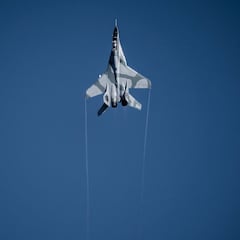How much military aid has the US supplied to Ukraine after Russia’s invasion?
As Ukrainian counter-offensives continue in the face of renewed Russian assaults in Donbas, a steady flow of hardware from allies remains a key factor.

The Pentagon has issued a complete list of the United States’ total military hardware commitment to Ukraine following Russia’s invasion on 24 February. The Kremlin launched what it still terms as a “special military operation” against its neighbouring country in response to the eastern expansion of the NATO military alliance and to carry out what Vladimir Putin described as an attempt to “demilitarize and denazify Ukraine.” After two and a half months of war, Russian forces have been pushed back from Kyiv and are now concentrating their offensive in the Donbas region, which comprises Donetsk and Luhansk, where fighting between pro-Russian separatists and Ukrainian forces has been raging for eight years.
In the wake of Russia’s invasion of Ukraine, which was facilitated with the aid of Belarus, the international community rushed to provide arms, munitions and tactical support to the government of Volodomir Zelenskyy. Several nations pledged support and a steady stream of defence systems and weapons flowed in, helping Ukraine’s armed forces to mount a successful defence of Kyiv and push Russian forces back from areas surrounding the capital. Senior Russian officers had predicted a swift victory but supply and logistical issues set in early in the invasion and morale among conscripted troops fell as Ukraine’s military proved to be more than a match for a statistically much larger and better-equipped force.
Reports are coming in that Russians are in a rush to annex Kherson region. Even without a fake referendum, because there is absolutely no popular support for the occupation, unlike in Donetsk, Luhansk in 2014. Also because they fear an upcoming Ukrainian counteroffensive there https://t.co/Knw3yv4p4F
— Olga Tokariuk (@olgatokariuk) May 11, 2022
Russian war aims shift after failed Kyiv offensive
Putin’s aim is now to seize control of the Donbas region and other swathes of southern and eastern Ukraine, including all of Ukraine’s Black Sea access points, and link these with Crimea, which was illegally annexed by the Kremlin in 2014. As such, Russian forces have concentrated their assaults on two fronts: in the south, where repeated ground assaults toward Odesa have been broken up, and southwards from Izyum, although fierce resistance there has stalled the invading forces and a successful Ukrainian counter-attack has also pushed Russian troops away from Kharkiv. Russian forces hold the Black Sea port city of Kherson and Mariupol’s defiance has now been largely suppressed, with the majority of the city on the north coast of the Sea of Azov now under Russian control.
Grateful to @SecBlinken & @SecDef for their 24/7 efforts over the past months to mobilize global support for Ukraine and get us the arms we need. Together, Ukraine and the US have solved numerous problems that seemed unsolvable. Any attempts to draw a wedge between us are futile.
— Dmytro Kuleba (@DmytroKuleba) May 11, 2022
Ukraine’s foreign minister targets complete liberation
Ukraine’s aim remains the same as it has been since 24 February: to push the invading Russian forces back to areas that were under the control of the Kremlin on the day of the invasion and demand reparations. Now though Ukraine’s Foreign Minister Dmytro Kuleba, buoyed by successful Ukrainian counter-offensives, has said that the defenders’ initial definition of victory has now shifted.
“Now if we are strong enough on the military front and we win the battle for Donbas, which will be crucial for the following dynamics of the war, of course the victory for us in this war will be the liberation of the rest of our territories,” Kuleba told the Financial Times.
Related stories
For Ukraine to sustain its momentum, the continued supply of weapons and defensive systems will be crucial. So far, Ukraine has received billions of dollars’ worth of military aid from EU and NATO countries and the US, but Ukrainian forces will need plenty more if Kuleba’s assertion that Russia can be thrown out of Donbas is to be achieved.
The US Congress passed another $40 billion in military and humanitarian aid for Ukraine on 10 May and has provided $3.8 billion in military assistance since Russia launched its invasion. On the day Congress passed its latest aid package, the Department of Defense issued a complete list of all hardware supplied to Ukraine’s armed forces since 24 February:
- Over 1,400 Stinger anti-aircraft systems;
- Over 5,500 Javelin anti-armor systems;
- Over 14,000 other anti-armor systems;
- Over 700 Switchblade Tactical Unmanned Aerial Systems;
- 90 155mm Howitzers and over 200,000 155mm artillery rounds;
- 72 Tactical Vehicles to tow 155mm Howitzers;
- 16 Mi-17 helicopters;
- Hundreds of Armored High Mobility Multipurpose Wheeled Vehicles;
- 200 M113 Armored Personnel Carriers;
- Over 7,000 small arms;
- Over 50,000,000 rounds of ammunition;
- 75,000 sets of body armor and helmets;
- 121 Phoenix Ghost Tactical Unmanned Aerial Systems;
- Laser-guided rocket systems;
- Puma Unmanned Aerial Systems;
- Unmanned Coastal Defense Vessels;
- 17 counter-artillery radars;
- Four counter-mortar radars;
- Two air surveillance radars;
- M18A1 Claymore anti-personnel munitions;
- C-4 explosives and demolition equipment for obstacle clearing;
- Tactical secure communications systems;
- Night vision devices, thermal imagery systems, optics, and laser rangefinders;
- Commercial satellite imagery services;
- Explosive ordnance disposal protective gear;
- Chemical, Biological, Radiological, Nuclear protective equipment;
- Medical supplies to include first aid kits;
- Electronic jamming equipment;
- Field equipment and spare parts.


